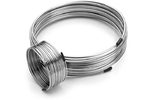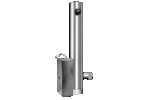- ▶
- Heaters/Source
- ▶
- Agilent Heaters and SensorsMass Spectrometry, Scientific Supplies & ManufacturingScientific Instrument Services 5973 Source Heater Tamper Resistant Allen Wrench 5973/5975 Quad Sensor 5985 Source Heater Assembly Agilent Interface Heater Assembly 5971 Interface Heater

- ▶
- Reference Material on InstrumentationArticle - A High Temperature Direct Probe for a Mass Spectrometer Design of a Direct Exposure Probe and Controller for use ona Hewlett-Packard 5989 Mass Spectrometer SIS AP1000 AutoProbe™ SIS AP2000 AutoProbe™ - Description of System HPP7: Direct Probe Electronics Console HPP7: Direct Probe for the Agilent (HP) 5973/5975 MSD HPP7: HP Direct Probe Application Notes HPP7: Installation Directions for the Direct Probe HPP7: Side Cover for the HP 5973 MSD HPP7: Support HPP7: Probe Inlet System for the Agilent (HP) 5973 and 5975 MSD with Automatic Indexed Stops HPP7: Theory of Operation of the Direct Probe and Probe Inlet System Direct Thermal Extraction Thermal Desorption Application Notes Environmental Thermal Desorption Application Notes Food Science Thermal Desorption Application Notes Forensic Thermal Desorption Application Notes GC Cryo-Trap Application Notes Headspace Application Notes Purge & Trap Thermal Desorption Application Notes Theory of Operation of the AutoDesorb® System AutoDesorb Notes for SIS Dealers Adsorbent Resin Application Notes Installation of the Short Path Thermal Desorption System on Agilent (HP) and Other GCs Installation of the Short Path Thermal Desorption System on a Varian 3400 GC AutoDesorb® System Development Team Thermal Desorption Applications and Reference Materials Installation of the Short Path Thermal Desorption System - TD5 Part I - Design & Operation of the Short Path ThermalDesorption System Installation Instructions for the Model 951 GC Cryo-Trap on the HP 5890 Series GC Installation Instructions for the Model 961 GC Cryo-Trap on the HP 5890 Series GC Operation of the Model 951/961 GC Cryo-Trap SIS GC Cryo Traps - Theory of Operation NIST/EPA/NIH Mass Spectral Enhancements - 1998 version (NIST98) SIMION 3D Ion Optics Class Mass Spectrometer Source Cleaning Methods MS Tip: Mass Spectrometer Source Cleaning Procedures Mass Spec Source Cleaning Procedures Micro-Mesh® Abrasive Sheets Research Papers Using New Era Syringe Pump Systems EI Positive Ion Spectra for Perfluorokerosene (PFK) Cap Liner Information How do I convert between fluid oz and milliliters? Which bottle material should I choose? Which bottle mouth should I choose? The Bottle Selection Guide CGA Connections for Gas Tanks Chemical Reaction Interface Mass Spectrometry (CRIMS)

- Instrument Tubing
- ▶
- Gas RegulatorsModel 3530 Series - Single Stage Purity Brass Regulator Model 3510 Series - Single Stage High Purity Stainless Steel Regulators Model 3120 Series - Dual Stage Purity Brass Regulator Model 3810 Series - Dual Stage High Purity Stainless Steel Regulators Tescom Gas Line Regulators 3420 Series Tescom Gas Line Regulators 3450 Series Concoa In-Line Regulators Model 304 Series Concoa In-Line Regulators Model 324 Series
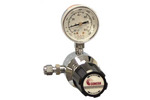
- TD
- ▶
- AccessoriesTD Supply Kit Desorption Tubes Adsorbent Resins Desorption Tube Needles Desorption Tube Seals Desorption System Fittings GC Cryo-Trap Extraction Cell TD Sample Loader Prepacked, Conditioned Desorption Tubes Desorption Tube Packing Accessories Stainless Steel Purge Heads Injection Port Liners Tenax TA Poster TD Application Notes Customer Service

- GCColumns Fused Silica Tubing Instrument Tubing Injection Port Liners Septa by Manufacturer SIS GC Cryo-Traps Ferrules Valves Swagelok® Fittings Pyrolysis Probe Accessories Gas Generators Gas Regulators Gas Purifiers and Filters Syringes SGE MEPS™-Micro Extraction by Packed Sorbent Purge and Trap System SGE SilFlow™ Stainless Steel Micro-Fluidic Platform Accessories NIST GC RI Library Other GC Supplies Catalog Page D1
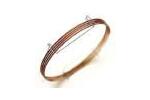
- ▶
- GC Cryo-traps
- LiteratureApplication Notes Adsorbent Resins Guide Mass Spec Tips SDS Sheets FAQ MS Calibration Compound Spectra Manuals MS Links/Labs/ Organizations MS Online Tools Flyers on Products/Services Scientific Supplies Catalog About Us NextAdvance Bullet Blender® Homogenizer Protocols Micro-Mesh® Literature Instrumentation Literature Agilent GC/MS Literature SIS News / E-Mail Newsletter NIST MS Database - Update Notifications

- ▶
- Thermal Desorption Applications and Reference MaterialsDirect Thermal Extraction Headspace Environmental Food Science Applications Pharmaceuticals Forensic Note 103: EPA Method 325B, Novel Thermal Desorption Instrument Modification to Improve Sensitivity Note 102: Identification of Contaminants in Powdered Beverages by Direct Extraction Thermal Desorption GC/MS Note 101: Identification of Contaminants in Powdered Foods by Direct Extraction Thermal Desorption GC/MS Note 100: Volatile and Semi-Volatile Profile Comparison of Whole Versus Cracked Versus Dry Homogenized Barley Grains by Direct Thermal Extraction Note 99: Volatile and Semi-Volatile Profile Comparison of Whole vs. Dry Homogenized Wheat, Rye and Barley Grains by Direct Thermal Extraction GC/MS Note 98: Flavor and Aroma Profiles of Truffle Oils by Thermal Desorption GC/MS Note 97: Flavor Profiles of Imported and Domestic Beers by Purge & Trap Thermal Desorption GC/MS Note 95: Detection of Explosives on Clothing Material by Direct and AirSampling Thermal Desorption GC/MS Note 94: Detection of Nepetalactone in the Nepeta Cataria Plant by Thermal Desorption GC/MS Note 93: Detection of Benzene in Carbonated Beverages with Purge & Trap Thermal Desorption GC/MS Note 88: Analysis of Silicone Contaminants on Electronic Components by Thermal Desorption GC-MS Note 84: Vacuum Pump Exhaust Filters - Charcoal Exhaust Traps Note 83: Vacuum Pump Exhaust Filters - Oil Mist Eliminators Note 82: Vacuum Pump Exhaust Filters Note 80: Design, Development and Testing of a Microprocessor ControlledAutomated Short Path Thermal Desorption Apparatus Note 79: Volatile Organic Compounds From Electron Beam Cured and Partially Electron Beam Cured Packaging Using Automated Short Path Thermal Desorption Note 77: The Determination of Volatile Organic Compounds in VacuumSystem Components Note 75: An Apparatus for Sampling Volatile Organics From LivePlant Material Using Short Path Thermal Desorption Note 73: The Analysis of Perfumes and their Effect on Indoor Air Pollution Note 71: Flavor Profile Determination of Rice Samples Using Shor tPath Thermal Desorption GC Methods Note 65: Determination of Ethylene by Adsorbent Trapping and Thermal Desorption - Gas Chromatography Note 64: Comparison of Various GC/MS Techniques For the Analysis of Black Pepper (Piper Nigrum) Note 63: Determination of Volatile and Semi-Volatile Organics in Printer Toners Using Thermal Desorption GC Techniques Note 60: Programmable Temperature Ramping of Samples Analyzed ViaDirect Thermal Extraction GC/MS Note 57: Aroma Profiles of Lavandula species Note 55: Seasonal Variation in Flower Volatiles Note 54: Identification of Volatile Organic Compounds in Office Products Note 43: Volatile Organic Composition In Blueberries Note 42: The Influence of Pump Oil Purity on Roughing Pumps Note 41: Hydrocarbon Production in Pine by Direct Thermal Extraction Note 40: Comparison of Septa by Direct Thermal Extraction Note 39: Comparison of Sensitivity Of Headspace GC, Purge and Trap Thermal Desorption and Direct Thermal Extraction Techniques For Volatile Organics Note 38: A New Micro Cryo-Trap For Trapping Of Volatiles At the Front Of a GC Capillary Column Note 37: Volatile Organic Emissions from Automobile Tires Note 36: Identification Of Volatile Organic Compounds In a New Automobile Note 35: Volatile Organics Composition of Cranberries Note 34: Selection Of Thermal Desorption and Cryo-Trap Parameters In the Analysis Of Teas Note 33: Changes in Volatile Organic Composition in Milk Over Time Note 32: Selection and Use of Adsorbent Resins for Purge and Trap Thermal Desorption Applications Note 31: Volatile Organic Composition in Several Cultivars of Peaches Note 30: Comparison Of Cooking Oils By Direct Thermal Extraction and Purge and Trap GC/MS Note 29: Analysis Of Volatile Organics In Oil Base Paints By Automated Headspace Sampling and GC Cryo-Focusing Note 28: Analysis Of Volatile Organics In Latex Paints By Automated Headspace Sampling and GC Cryo-Focusing Note 27: Analysis of Volatile Organics In Soils By Automated Headspace GC Note 26: Volatile Organics Present in Recycled Air Aboard a Commercial Airliner Note 25: Flavor and Aroma in Natural Bee Honey Note 24: Selection of GC Guard Columns For Use With the GC Cryo-Trap Note 23: Frangrance Qualities in Colognes Note 22: Comparison Of Volatile Compounds In Latex Paints Note 21: Detection and Identification Of Volatile and Semi-Volatile Organics In Synthetic Polymers Used In Food and Pharmaceutical Packaging Note 20: Using Direct Thermal Desorption to Assess the Potential Pool of Styrene and 4-Phenylcyclohexene In Latex-Backed Carpets Note 19: A New Programmable Cryo-Cooling/Heating Trap for the Cryo-Focusing of Volatiles and Semi-Volatiles at the Head of GC Capillary Columns Note 18: Determination of Volatile Organic Compounds In Mushrooms Note 17: Identification of Volatile Organics in Wines Over Time Note 16: Analysis of Indoor Air and Sources of Indoor Air Contamination by Thermal Desorption Note 14: Identification of Volatiles and Semi-Volatiles In Carbonated Colas Note 13: Identification and Quantification of Semi-Volatiles In Soil Using Direct Thermal Desorption Note 12: Identification of the Volatile and Semi-Volatile Organics In Chewing Gums By Direct Thermal Desorption Note 11: Flavor/Fragrance Profiles of Instant and Ground Coffees By Short Path Thermal Desorption Note 10: Quantification of Naphthalene In a Contaminated Pharmaceutical Product By Short Path Thermal Desorption Note 9: Methodologies For the Quantification Of Purge and Trap Thermal Desorption and Direct Thermal Desorption Analyses Note 8: Detection of Volatile Organic Compounds In Liquids Utilizing the Short Path Thermal Desorption System Note 7: Chemical Residue Analysis of Pharmaceuticals Using The Short Path Thermal Desorption System Note 6: Direct Thermal Analysis of Plastic Food Wraps Using the Short Path Thermal Desorption System Note 5: Direct Thermal Analysis Using the Short Path Thermal Desorption System Note 4: Direct Analysis of Spices and Coffee Note 3: Indoor Air Pollution Note 2: Detection of Arson Accelerants Using Dynamic Headspace with Tenax® Cartridges Thermal Desorption and Cryofocusing Note 1: Determination of Off-Odors and Other Volatile Organics In Food Packaging Films By Direct Thermal Analysis-GC-MS

- Purge & Trap Thermal Desorption Application NotesNote 97: Flavor Profiles of Imported and Domestic Beers by Purge & Trap Thermal Desorption GC/MS Note 93: Detection of Benzene in Carbonated Beverages with Purge & Trap Thermal Desorption GC/MS Note 43: Volatile Organic Composition In Blueberries Note 42: The Influence of Pump Oil Purity on Roughing Pumps Note 38: A New Micro Cryo-Trap For Trapping Of Volatiles At the Front Of a GC Capillary Column Note 35: Volatile Organics Composition of Cranberries Note 34: Selection Of Thermal Desorption and Cryo-Trap Parameters In the Analysis Of Teas Note 33: Changes in Volatile Organic Composition in Milk Over Time Note 32: Selection and Use of Adsorbent Resins for Purge and Trap Thermal Desorption Applications Note 31: Volatile Organic Composition in Several Cultivars of Peaches Note 30: Comparison Of Cooking Oils By Direct Thermal Extraction and Purge and Trap GC/MS Note 26: Volatile Organics Present in Recycled Air Aboard a Commercial Airliner Note 25: Flavor and Aroma in Natural Bee Honey Note 23: Frangrance Qualities in Colognes Note 22: Comparison Of Volatile Compounds In Latex Paints Note 21: Detection and Identification Of Volatile and Semi-Volatile Organics In Synthetic Polymers Used In Food and Pharmaceutical Packaging Note 20: Using Direct Thermal Desorption to Assess the Potential Pool of Styrene and 4-Phenylcyclohexene In Latex-Backed Carpets Note 18: Determination of Volatile Organic Compounds In Mushrooms Note 17: Identification of Volatile Organics in Wines Over Time Note 16: Analysis of Indoor Air and Sources of Indoor Air Contamination by Thermal Desorption Note 14: Identification of Volatiles and Semi-Volatiles In Carbonated Colas Note 8: Detection of Volatile Organic Compounds In Liquids Utilizing the Short Path Thermal Desorption System Note 3: Indoor Air Pollution Note 2: Detection of Arson Accelerants Using Dynamic Headspace with Tenax® Cartridges Thermal Desorption and Cryofocusing

- GC Cryo-Trap Application NotesNote 43: Volatile Organic Composition In Blueberries Note 42: The Influence of Pump Oil Purity on Roughing Pumps Note 41: Hydrocarbon Production in Pine by Direct Thermal Extraction Note 40: Comparison of Septa by Direct Thermal Extraction Note 39: Comparison of Sensitivity Of Headspace GC, Purge and Trap Thermal Desorption and Direct Thermal Extraction Techniques For Volatile Organics Note 38: A New Micro Cryo-Trap For Trapping Of Volatiles At the Front Of a GC Capillary Column Note 37: Volatile Organic Emissions from Automobile Tires Note 36: Identification Of Volatile Organic Compounds In a New Automobile Note 34: Selection Of Thermal Desorption and Cryo-Trap Parameters In the Analysis Of Teas Note 31: Volatile Organic Composition in Several Cultivars of Peaches Note 30: Comparison Of Cooking Oils By Direct Thermal Extraction and Purge and Trap GC/MS Note 29: Analysis Of Volatile Organics In Oil Base Paints By Automated Headspace Sampling and GC Cryo-Focusing Note 28: Analysis Of Volatile Organics In Latex Paints By Automated Headspace Sampling and GC Cryo-Focusing Note 27: Analysis of Volatile Organics In Soils By Automated Headspace GC Note 24: Selection of GC Guard Columns For Use With the GC Cryo-Trap Note 19: A New Programmable Cryo-Cooling/Heating Trap for the Cryo-Focusing of Volatiles and Semi-Volatiles at the Head of GC Capillary Columns

- Adsorbent Resin Application NotesNote 39: Comparison of Sensitivity Of Headspace GC, Purge and Trap Thermal Desorption and Direct Thermal Extraction Techniques For Volatile Organics Note 34: Selection Of Thermal Desorption and Cryo-Trap Parameters In the Analysis Of Teas Note 32: Selection and Use of Adsorbent Resins for Purge and Trap Thermal Desorption Applications

- Application NotesNote 103: EPA Method 325B, Novel Thermal Desorption Instrument Modification to Improve Sensitivity Note 102: Identification of Contaminants in Powdered Beverages by Direct Extraction Thermal Desorption GC/MS Note 101: Identification of Contaminants in Powdered Foods by Direct Extraction Thermal Desorption GC/MS Note 100: Volatile and Semi-Volatile Profile Comparison of Whole Versus Cracked Versus Dry Homogenized Barley Grains by Direct Thermal Extraction Note 99: Volatile and Semi-Volatile Profile Comparison of Whole vs. Dry Homogenized Wheat, Rye and Barley Grains by Direct Thermal Extraction GC/MS Note 98: Flavor and Aroma Profiles of Truffle Oils by Thermal Desorption GC/MS Note 97: Flavor Profiles of Imported and Domestic Beers by Purge & Trap Thermal Desorption GC/MS Note 96: Reducing Warping in Mass Spectrometer Filaments, with SISAlloy® Yttria/Rhenium Filaments Note 95: Detection of Explosives on Clothing Material by Direct and AirSampling Thermal Desorption GC/MS Note 94: Detection of Nepetalactone in the Nepeta Cataria Plant by Thermal Desorption GC/MS Note 93: Detection of Benzene in Carbonated Beverages with Purge & Trap Thermal Desorption GC/MS Note 92: Yttria Coated Mass Spectrometer Filaments Note 91: AutoProbe DEP Probe Tip Temperatures Note 90: An Automated MS Direct Probe for use in an Open Access Environment Note 89: Quantitation of Organics via a Mass Spectrometer Automated Direct Probe Note 88: Analysis of Silicone Contaminants on Electronic Components by Thermal Desorption GC-MS Note 87: Design and Development of an Automated Direct Probe for a Mass Spectrometer Note 86: Simulation of a Unique Cylindrical Quadrupole Mass Analyzer Using SIMION 7.0. Note 85: Replacing an Electron Multiplier in the Agilent (HP) 5973 MSD Note 84: Vacuum Pump Exhaust Filters - Charcoal Exhaust Traps Note 83: Vacuum Pump Exhaust Filters - Oil Mist Eliminators Note 82: Vacuum Pump Exhaust Filters Note 81: Rapid Bacterial Chemotaxonomy By DirectProbe/MSD Note 80: Design, Development and Testing of a Microprocessor ControlledAutomated Short Path Thermal Desorption Apparatus Note 79: Volatile Organic Compounds From Electron Beam Cured and Partially Electron Beam Cured Packaging Using Automated Short Path Thermal Desorption Note 78: A New Solution to Eliminate MS Down-Time With No-Tool-Changing of Analytical GC Columns Note 77: The Determination of Volatile Organic Compounds in VacuumSystem Components Note 76: Determination of the Sensitivity of a CRIMS System Note 75: An Apparatus for Sampling Volatile Organics From LivePlant Material Using Short Path Thermal Desorption Note 74: Examination of Source Design in Electrospray-TOF Using SIMION 3D Note 73: The Analysis of Perfumes and their Effect on Indoor Air Pollution Note 72: 1998 Version of the NIST/EPA/NIH Mass Spectral Library, NIST98 Note 71: Flavor Profile Determination of Rice Samples Using Shor tPath Thermal Desorption GC Methods Note 70: Application of SIMION 6.0 To a Study of the Finkelstein Ion Source: Part II Note 69: Application of SIMION 6.0 To a Study of the Finkelstein Ion Source: Part 1 Note 68: Use of a PC Plug-In UV-Vis Spectrometer To Monitor the Plasma Conditions In GC-CRIMS Note 67: Using Chemical Reaction Interface Mass Spectrometry (CRIMS) To Monitor Bacterial Transport In In Situ Bioremediation Note 66: Probe Tip Design For the Optimization of Direct Insertion Probe Performance Note 65: Determination of Ethylene by Adsorbent Trapping and Thermal Desorption - Gas Chromatography Note 64: Comparison of Various GC/MS Techniques For the Analysis of Black Pepper (Piper Nigrum) Note 63: Determination of Volatile and Semi-Volatile Organics in Printer Toners Using Thermal Desorption GC Techniques Note 62: Analysis of Polymer Samples Using a Direct Insertion Probe and EI Ionization Note 61: Analysis of Sugars Via a New DEP Probe Tip For Use With theDirect Probe On the HP5973 MSD Note 60: Programmable Temperature Ramping of Samples Analyzed ViaDirect Thermal Extraction GC/MS Note 59: Computer Modeling of a TOF Reflectron With Gridless Reflector Using SIMION 3D Note 58: Direct Probe Analysis and Identification of Multicomponent Pharmaceutical Samples via Electron Impact MS Note 57: Aroma Profiles of Lavandula species Note 56: Mass Spec Maintenance & Cleaning Utilizing Micro-Mesh® Abrasive Sheets Note 55: Seasonal Variation in Flower Volatiles Note 54: Identification of Volatile Organic Compounds in Office Products Note 53: SIMION 3D v6.0 Ion Optics Simulation Software Note 52: Computer Modeling of Ion Optics in Time-of-Flight mass Spectrometry Using SIMION 3D Note 51: Development and Characterization of a New Chemical Reaction Interface for the Detection of Nonradioisotopically Labeled Analytes Using Mass Spectrometry (CRIMS) Note 50: The Analysis of Multiple Component Drug Samples Using a Direct Probe Interfaced to the HP 5973 MSD Note 49: Analysis of Cocaine Utilizing a New Direct Insertion Probe on a Hewlett Packard 5973 MSD Note 48: Demonstration of Sensitivity Levels For the Detection of Caffeine Using a New Direct Probe and Inlet for the HP 5973 MSD Note 47: The Application Of SIMION 6.0 To Problems In Time-of-Flight Mass Spectrometry Note 46: Delayed Extraction and Laser Desorption: Time-lag Focusing and Beyond Note 45: Application of SIMION 6.0 to Filament Design for Mass Spectrometer Ionization Sources Note 44: The Design Of a New Direct Probe Inlet For a Mass Spectrometer Note 43: Volatile Organic Composition In Blueberries Note 42: The Influence of Pump Oil Purity on Roughing Pumps Note 41: Hydrocarbon Production in Pine by Direct Thermal Extraction Note 40: Comparison of Septa by Direct Thermal Extraction Note 39: Comparison of Sensitivity Of Headspace GC, Purge and Trap Thermal Desorption and Direct Thermal Extraction Techniques For Volatile Organics Note 38: A New Micro Cryo-Trap For Trapping Of Volatiles At the Front Of a GC Capillary Column Note 37: Volatile Organic Emissions from Automobile Tires Note 36: Identification Of Volatile Organic Compounds In a New Automobile Note 35: Volatile Organics Composition of Cranberries Note 34: Selection Of Thermal Desorption and Cryo-Trap Parameters In the Analysis Of Teas Note 33: Changes in Volatile Organic Composition in Milk Over Time Note 32: Selection and Use of Adsorbent Resins for Purge and Trap Thermal Desorption Applications Note 31: Volatile Organic Composition in Several Cultivars of Peaches Note 30: Comparison Of Cooking Oils By Direct Thermal Extraction and Purge and Trap GC/MS Note 29: Analysis Of Volatile Organics In Oil Base Paints By Automated Headspace Sampling and GC Cryo-Focusing Note 28: Analysis Of Volatile Organics In Latex Paints By Automated Headspace Sampling and GC Cryo-Focusing Note 27: Analysis of Volatile Organics In Soils By Automated Headspace GC Note 26: Volatile Organics Present in Recycled Air Aboard a Commercial Airliner Note 25: Flavor and Aroma in Natural Bee Honey Note 24: Selection of GC Guard Columns For Use With the GC Cryo-Trap Note 23: Frangrance Qualities in Colognes Note 22: Comparison Of Volatile Compounds In Latex Paints Note 21: Detection and Identification Of Volatile and Semi-Volatile Organics In Synthetic Polymers Used In Food and Pharmaceutical Packaging Note 20: Using Direct Thermal Desorption to Assess the Potential Pool of Styrene and 4-Phenylcyclohexene In Latex-Backed Carpets Note 19: A New Programmable Cryo-Cooling/Heating Trap for the Cryo-Focusing of Volatiles and Semi-Volatiles at the Head of GC Capillary Columns Note 18: Determination of Volatile Organic Compounds In Mushrooms Note 17: Identification of Volatile Organics in Wines Over Time Note 16: Analysis of Indoor Air and Sources of Indoor Air Contamination by Thermal Desorption Note 14: Identification of Volatiles and Semi-Volatiles In Carbonated Colas Note 13: Identification and Quantification of Semi-Volatiles In Soil Using Direct Thermal Desorption Note 12: Identification of the Volatile and Semi-Volatile Organics In Chewing Gums By Direct Thermal Desorption Note 11: Flavor/Fragrance Profiles of Instant and Ground Coffees By Short Path Thermal Desorption Note 10: Quantification of Naphthalene In a Contaminated Pharmaceutical Product By Short Path Thermal Desorption Note 9: Methodologies For the Quantification Of Purge and Trap Thermal Desorption and Direct Thermal Desorption Analyses Note 8: Detection of Volatile Organic Compounds In Liquids Utilizing the Short Path Thermal Desorption System Note 7: Chemical Residue Analysis of Pharmaceuticals Using The Short Path Thermal Desorption System Note 6: Direct Thermal Analysis of Plastic Food Wraps Using the Short Path Thermal Desorption System Note 5: Direct Thermal Analysis Using the Short Path Thermal Desorption System Note 4: Direct Analysis of Spices and Coffee Note 3: Indoor Air Pollution Note 2: Detection of Arson Accelerants Using Dynamic Headspace with Tenax® Cartridges Thermal Desorption and Cryofocusing Note 1: Determination of Off-Odors and Other Volatile Organics In Food Packaging Films By Direct Thermal Analysis-GC-MS Tech No. "A" Note 14: Elimination of "Memory" Peaks in Thermal Desorption Improving Sensitivity in the H.P. 5971 MSD and Other Mass Spectrometers - Part I of II Improving Sensitivity in the H.P. 5971 MSD and Other Mass Spectrometers- Part II of II Adsorbent Resins Guide Development and Field Tests of an Automated Pyrolysis Insert for Gas Chromatography. Hydrocarbon Production in Pine by Direct Thermal Extraction A New Micro Cryo-Trap for the Trapping of Volatiles at the Front of a GC Capillary (019P) - Comparison of Septa by Direct Thermal Extraction Volatile Organic Composition in Blueberry Identification of Volatile Organic Compounds in Office Products Detection and Indentification of Volatiles in Oil Base Paintsby Headspace GC with On Column Cryo-Trapping Evaluation of Septa Using a Direct Thermal Extraction Technique INFLUENCE OF STORAGE ON BLUEBERRY VOLATILES Selection of Thermal Desorption and Cryo-Trap Parameters in the Analysis of Teas Redesign and Performance of a Diffusion Based Solvent Removal Interface for LC/MS The Design of a New Direct Probe Inlet for a Mass Spectrometer Analytes Using Mass Spectrometry (CRIMS) Application of SIMION 6.0 to Filament Design for Mass Spectrometer Ionization Sources A Student Guide for SIMION Modeling Software Application of SIMION 6.0 to Problems in Time-of-flight Mass Spectrometry Comparison of Sensitivity of Headspace GC, Purge and TrapThermal Desorption and Direct Thermal Extraction Techniques forVolatile Organics The Influence of Pump Oil Purity on Roughing Pumps Analysis of Motor Oils Using Thermal Desorption-Gas Chromatography-Mass Spectrometry IDENTIFICATION OF VOLATILE ORGANIC COMPOUNDS IN PAPER PRODUCTS Computer Modeling of Ion Optics in Time-of-Flight mass Spectrometry using SIMION 3D Seasonal Variation in Flower Volatiles Development of and Automated Microprocessor Controlled Gas chromatograph Fraction Collector / Olfactometer Delayed Extraction and Laser Desorption: Time-lag Focusing and Beyond A New Micro Cryo-Trap for the Trapping of Volatiles at the Front of a GC Column Design of a Microprocessor Controlled Short Path Thermal Desorption Autosampler Computer Modeling of Ion Optics in Time-of-Flight Mass Spectrometry Using SIMION 3D Thermal Desorption Instrumentation for Characterization of Odors and Flavors

- ▶
- Note 34: Selection Of Thermal Desorption and Cryo-Trap Parameters In the Analysis Of Teas (This Page)
1999
INTRODUCTION
The range of organics in a sample such as green and black teas can range from very light gases to very large organics. The techniques available to analyze these samples include headspace GC, Purge and Trap thermal desorption (P&T TD), direct thermal extraction (DTE), solvent extraction and newer techniques, as solid phase micro extraction (SPME) and supercritical fluid extraction (SFE). Proper selection of the analysis technique as well as optimization of the system parameters is required to achieve the desired results. One of the best techniques to analyze food products for flavors is the Purge and Trap System combined with cryo-focusing of the analytes at the front of the GC column before analysis. Through the selection of the purge and trap sampling temperature, GC and thermal desorption system parameters and cryo-trap parameters the range of volatile and non-volatile organics that are analyzed can be selected. In the following article, we are utilizing samples of green and black tea via the Purge and Trap Technique (P&T) with the Short Path Thermal Desoption System (SPDT) to study the P&T parameters, thermal desorption parameters and cyro-trapping parameters which can be adjusted to selectively analyze a range of analytes in these samples. Through the selection of these parameters, data can be obtained similar to what would be received via other techniques such as multidimensional chromatography.
Sampling Technique
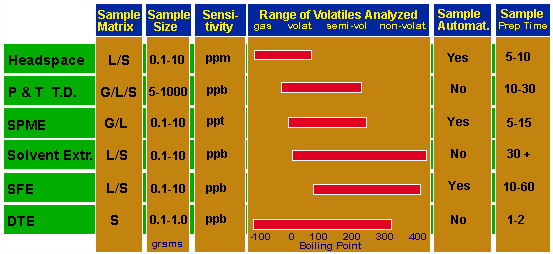
Figure 1 - Comparison of GC Sampling and Sample Introduction Techniques
In order to study the volatile organics responsible the aroma and flavor in food products such as teas, a variety of GC sampling techniques can be utilized (Figure 1). These six major sample preparation and GC introduction techniques can be used for the analysis of volatiles and semi-volatiles in food products. Each of these techniques has their unique advantages and disadvantages in the analysis of volatiles and semi-volatiles in food products. The selection of the particular volatile extraction technique or GC injection technique is effected by a number of factors (Table I) which must be considered both for the selection of the sampling technique as well as in its setup and operation. These advantages and disadvantages are briefly described below.
Table I - Factors to Consider in the Selection of a Method for the Analysis of Volatiles in Food Products
- Sample Matrix - Gas - Liquid - Solid
- Amount of Sample Available for Analysis
- Concentration of Volatiles in the Sample Matrix
- Detection Limit of GC Detector
- Amount of Water in the Sample
- Solvents or Major Interfering Compounds
- Thermal Stability of the Analytes in the Sample
- Range of Volatiles and Semi-Volatiles in the Sample
- Range of Volatiles and Semi-Volatiles Desired in Analysis Results
- Number of Samples to be Analyzed
- Sample Preparation Time
- Cost of Analysis
- Cost of and Disposal of Solvents
Headspace
Headspace is a technique which has been around for a long time. It is most suited for the analysis of the very light volatiles in samples that can be efficiently partitioned into the head space gas volume from the liquid or solid matrix sample. Higher boiling volatiles and semi-volatiles are not detectable with this technique. In addition, the sensitivity of the technique is limited, typically to concentrations in the ppm to ppt range. However, the technique is a preferred method for the analysis of gases and very light volatiles which can not be analyzed by other techniques such as P&T Thermal Desorption. The technique is also a preferred technique when sample automation is required and is also a used in screening of samples.
Solid Phase Micro Extraction
Solid Phase Micro Extraction (SPME) is currently a new and popular technique. It requires minimal accessory equipment (low cost) and is easy to use. Its major shortcomings are the lack of sensitivity (ppt) and the limited range of volatiles which can be analyzed. It works very well with the less volatiles organics such as PCB's and can be automated.
P&T TD
Purge and Trap (P&T) Thermal Desorption is also a very popular technique and is routinely used for the analysis of volatiles in environmental samples as well as food samples. Through the proper selection of adsorbent resins such as Tenax® TA, water can be eliminated from being introduced into the GC. This is important for the analysis of high water content samples such as food products. The Purge and Trap technique is more sensitive by at least a factor of 1000 over headspace techniques. Typical sensitivity is in the ppb range. By purging samples at higher temperatures, higher molecular weight compounds can be detected. However, the Purge and Trap technique requires more time for sample preparation and can not normally be automated (an automated version of the SPTD System is about 2 years away from production). In addition, very light volatiles and gases will not be trapped on the adsorbent resins and therefore will be missed in the analysis. The P&T technique has proven to be the optimal method for the analysis of flavors in food due to its high sensitivity and the ability to eliminate the water from the sample for analysis. Volatiles ranging from pentane through the terpenes can readily be analyzed with this technique.
Solvent Extraction
Solvent extraction has been routinely utilized for the analysis of flavors in foods. However, it has several limitations and disadvantages. Since the cost and disposal of solvents is dramatically increasing, other methods will be needed in the future to replace costly solvent extraction. Also, the technique is limited in the range of volatiles that can be analyzed with solvent extraction. During the evaporation or reduction steps in solvent extraction, all of the very volatile compounds and much of the volatile organics will be lost due to evaporation. Proper selection of solvents is required in order to achieve good extraction and separation of the analytes and a wide range of analytes may not be able to be analyzed in one analysis. However, for the analysis of the semivolatiles and non volatile organics, solvent extraction is probably the method of choice. Detection limits for the non-volatile organics are in the ppb range.
Super Critical Fluid Extraction
Super Critical Fluid Extraction (SFE) is also a very popular technique for the analysis of organics in food products. It is an appropriate technique for the analysis of the less volatile compounds, much like solvent extraction. It has limitations for the range of analytes that can be extracted simultaneously. This limits its usefulness for the analysis of food products with 200 or more volatile and semi-volatile compounds. However, if you are looking for a particular semi-volatile analyte or a narrow selection of analytes, this technique is preferable over solvent extraction. This technique can be automated which also makes it advantageous in many instances.
Direct Thermal Extraction
Direct Thermal Extraction (DTE) is a new technique which is unique to the SIS Short Path Thermal Desorption System. In this technique, volatiles and semi-volatiles can be thermally extracted directly from solid matrix samples without the use of any solvents or any other sample preparation. The advantages of this technique are that a wide range of volatiles and semi-volatiles can be analyzed and the high sensitivity of the technique (typically ppb ranges on samples less than 1.0 gram). Its main disadvantage is the extraction of water into the GC column which will form an ice plug. Most food products contain a high degree of water making this technique not practical. However, for dried food products such as spices and teas, this technique can be utilized. Since no sample preparation is required, the sampling time is small, just weigh the sample into the desorption tube and analyze it. Figure 2 compares the Purge and Trap technique with the Direct Thermal Extraction Technique of a sample of Green Tea. The DTE technique will detect lower molecular weight volatiles than the P&T technique because these volatiles would normally pass through the adsorbent resin in the P&T desorption tube. The DTE technique will also detect higher molecular weight volatiles, because they are extracted directly from the sample thermally at higher temperatures than can be achieved with P&T sampling. Lastly, the DTE extraction technique is more sensitive by at least a factor 10 to 100. In the example in Figure 2, the DTE sample was split 20:1 whereas the P&T sample was not split.
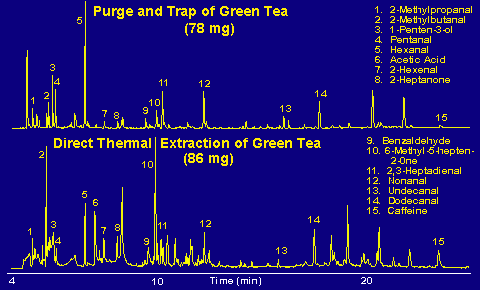
Figure 2 - Comparison Of the Direct Thermal Extraction Technique and Purge and Trap For Teas
Experimental
For most of the samples shown below, 200 milligrams of Black Tea was weighed into a 10.0 ml purge and trap tube and 5.0 ml of distilled water was added. The Purge and Trap Apparatus is described in Application Notes No. 18, 22, 25, 30, 31 and 33. The purge and trap vessel was heated to the temperatures listed below in a hot water bath, and the volatiles were extracted using high purity helium in the Purge and Trap system at a flow rate of 22.5 ml per minute and sampled for 20 minutes (450 ml total). The volatiles were purged onto a desorption tube containing 100 milligrams of Tenax TA which had been previously conditioned. A dry purge of 20 ml per minute was also used to prevent the condensation of water on the adsorbent resin. After sample collection, the desorption tube was purged at room temperature with an additional 100 ml of helium to remove the water from the Tenax resin on the trap.
The desorption tubes were then attached to the Scientific Instrument Services Short Path Thermal Desorption System and thermally desorbed at 250 degrees C, a desorption flow rate of 4 ml per minute for 5 minutes into the GC injection port. The GC injection port was maintained at 250 degrees C, and the volatiles were cryo-focused at the front of the GC column using the Scientific Instrument Services GC Cryo-Trap at a temperature of -70 degrees C. After the desorption process was complete, the GC Cryo-Trap was ballistically heated to 225 degrees C to release the trapped volatiles in a narrow band for chromatography. An H.P. 5890 Series II GC with Electron Pressure Control attached to the HP 5989A Engine Mass Spectrometer was used for the analysis and identification of the analytes. A J&W DB5-MS capillary column was used (60 meter x 0.32 mm x 0.25u film thickness) at a flow rate of 1.8 ml/min. The GC oven was programmed from 30 degrees to 250 degrees at 10 degrees per minute. The analytes were detected using the mass spec to scan the mass range from 25 to 400 daltons.
Results and Discussion
P&T Sampling Temperature
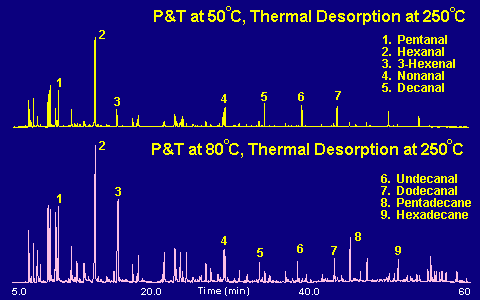
Figure 3 - Effect of Purge and Trap Sampling Temperature During Sample Collection
The higher the temperature of the Purge Trap, the higher the range of volatiles which will be extracted from the sample. This is shown in Figure 3. Two identical samples of black tea (200 milligrams in 5.0 ml of water) were purged with 450 ml of Helium at 50 degrees and 80 degrees C onto a Tenax Trap. After collection, the desorption tubes were purged off line with an additional 100 ml of dry helium to remove the water from the Tenax trap. The Tenax traps were then desorbed at 250 degrees into the GC, Cryo-Trapped at -70 degrees and then analyzed. As expected, a wider range of volatiles was extracted from the sample at the higher sampling temperature. However, the limitation of sampling is about 90 degrees C with this technique due to the water present in the sample matrix. Higher temperatures would saturate the adsorbent with water making it useless for trapping and sample analysis.
Purging To Remove Volatiles
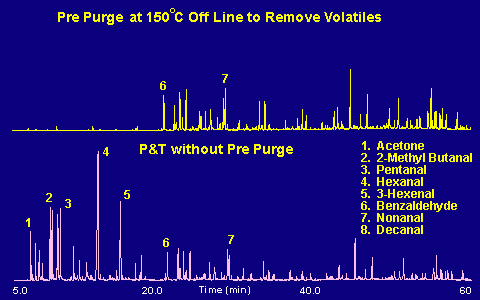
Figure 4 - Effect Of Purging Tenax Trap To Remove Volatiles
Purging samples collected on thermal desorption resins can be used to remove unwanted lower molecular weight volatiles. The purging step after sample collection in Figure 3 was used to remove the water from the sample. Longer purge times or purging samples at higher temperatures can be used to selectively remove additional volatiles from the sample being analyzed. Figure # 4 (top chromatogram) shows the same samples of black tea collected on a Tenax trap. After collection, the desorption tube was attached to the thermal desorption system but NO needle was attached. The desorption system blocks were set to 150 degrees C and the desorption tube was inserted into the blocks, heated to 150 degrees and purged with 200 ml of helium. After this initial purge, a transfer line needle was attached to the desorption tube, the desorption tube blocks were reset to 250 degree C and the sample was analyzed using the thermal desorption system. The more volatile analytes are not present in this chromatogram, since they were eliminated in the 150 degree purging step. This technique is often used to simplify a chromatogram or more often to remove large components from the sample. For instance, when analyzing wine samples, the amount of ethanol is so great that it would produce an enormous broad GC peak that would interfere with the analysis. By selectively purging the Tenax Trap with helium, the ethanol can be eliminated and the analysis of the volatiles and flavors in wine can be easily accomplished.
Thermal Desorption Temperature
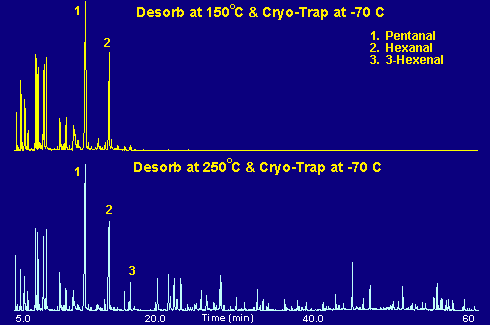
Figure 5 - Effect Of Desorption Temperature On Sample Analysis
The thermal desorption temperature can also be used to select the range of volatiles or semi-volatiles that will be thermally desorbed into the GC and detected. In the blacks teas shown in Figure 5, the same black teas were prepared as described previously and then desorbed at temperatures of 150 degrees and 250 degrees C. At the lower temperature, only the lower range of volatiles can be observed. The higher molecular weight analytes are still on the adsorbent resin. At the higher temperature, both the higher molecular weight volatiles and semi-volatiles are detected.
The combination of purging time to remove lower molecular weight volatiles and desorption temperature to observe higher molecular weight volatiles can be used in combination to selectively extract fractions from samples being analyzed via the Purge and Trap Thermal Desorption technique. Results similar to multidimensional chromatography are achievable by selecting these parameters for the particular analytes of interest.
Fractional Thermal Desorption
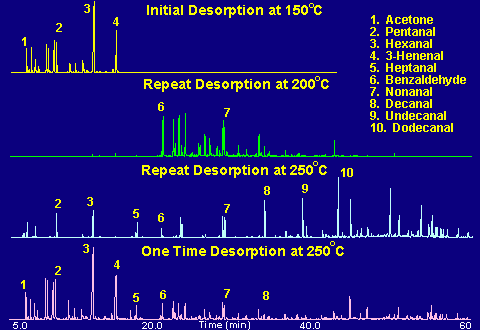
Figure 6 - Fractional Thermal Desorption Of Black Tea
It is also possible to sequentially desorb the same sample at consecutively higher temperatures. This is shown in Figure 6. The same sample of black tea was prepared as before. The sample was then desorbed at 150 degrees and analyzed. The same sample was then redesorbed at 200 degrees and analyzed again. Finally, the same sample was desorbed a third time at 250 degrees. At 150 degrees C, only the lower boilers were detected. At 200 degrees, the lower boilers were missing, since they were extracted for the previous chromatogram, and only the medium boilers were detected. However, at 250 degrees C, not only higher boilers were detected, but also many of the lower boiler reappeared. These lower boilers were mainly aldehydes. This is probably due to the thermal decomposition of the acids to their corresponding aldehyde at the higher desorption temperatures.
Cryo-Trap Temperature
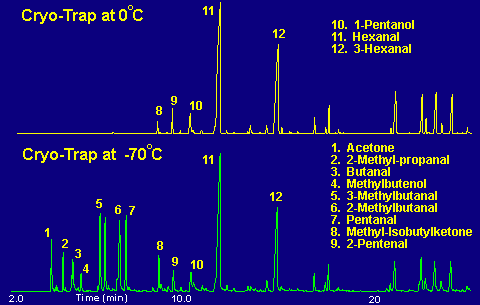
Figure 7 - Effect of Cryo-Trap Temperatures Of Black Tea
Finally, the Cryo-Trap temperature can be selected to trap specific ranges of volatiles. The lower the temperature of the GC Cryo-Trap, the lower the range of volatiles that will be detected by the GC. In Figure 7, two samples of the same black tea were trapped at 0 degrees C and -70 degrees C. More than 12 additional volatiles are seen at the lower temperature which are not trapped at the higher temperature. At the higher temperature, the very light volatiles are not trapped and therefore are not seen in the chromatogram. They would be present as broad peaks in the early (first 5 minutes) parts of the total chromatogram. This technique is often used to eliminate low boiling volatiles from the sample being analyzed. For example, by trapping at +10 degrees C, no water will be trapped and therefore will not interfere with the analysis. However, when using this technique, it is important to set the cryo-trap time to at least 5.0 minutes after the sample has been collected. This long trapping time will give the GC column sufficient time to elute these compounds through the GC column so that they do not interfere with the subsequent sample analysis.
Conclusion
Table II - Parameters Which can be Adjusted to Select Analytes for Analysis
Temperature Parameter Low Temperature High Temperature ----------------------------- ------------------------------ ----------------------------- Purge and Trap Temp Purge only low boilers Purge low and High boilers Post Purge of Desorption Tube Remove water and low volatiles Remove higher boilers Thermal Desorption Blocks Extract low boilers only Extract low and high boilers Cryo-Trap Temperature Trap Low and high boilers Trap high boilers only
A variety of techniques are available for the sample collection and analysis of volatiles in food samples as well as other samples. One of the more popular techniques is the Purge and Trap Thermal Desorption technique in conjunction with the GC Cryo-Trap. By proper selection of the system parameters including sampling temperature, desorption tube purging, desorption temperature and cryo-trap temperature selective results can be obtained as listed in Table II. Interfering compounds can be eliminated from the chromatogram or analysis time can be shortened to analyze for specific analytes. In other cases where a wide range of volatiles is desired, the system parameters can be adjusted to analyze the majority if not all of the analytes of interest in the sample matrix. These parameters can be optimized to achieve analysis results similar to multidimensional analysis but at a much lower cost in both equipment and equipment expertise.


